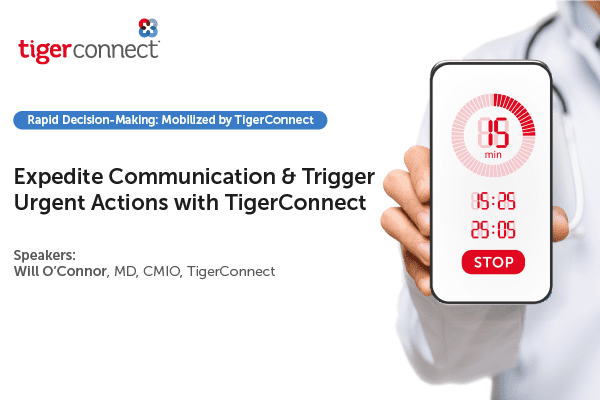Home / Blog /
Speed to Diagnosis: How Clinical Collaboration Improves Patient Throughput

Speed to Diagnosis: How Clinical Collaboration Improves Patient Throughput
Hospitals and health systems are faced with a growing number of patients, extended hours, and staff shortages. It’s no surprise that the ability to accelerate patient throughput and improve quality care is challenging. According to the Centers for Disease Control, there are more than 130 million hospital visits every year. Once triaged, about 16.2 million of these patients are admitted for treatment. Unfortunately, this is stretching an already overburdened system, meaning more than 50% of patients experience extended wait times.
In fact, a recent survey showed that 53% of patients with limited healthcare access reportedly left appointments due to long wait times. Across physician specialties, times averaged 18 minutes or more. As many providers are juggling patients and paperwork, it’s also reported that most doctors spend only 20 minutes per patient.
Poor patient throughput – the flow of patients through the healthcare ecosystem – is becoming a juggernaut for organizations to overcome. However, the cure for patient throughput is increasingly being found in better clinical collaboration and communication.
Expedite Communication and Trigger Urgent Actions with TigerConnect
Impact patient outcomes & the bottom-line through expedited communication
|
 |
Clinical Collaboration and Communication: Driving Better Patient Throughput
Never underestimate the power of clear communication – especially in the healthcare industry. In most cases, patient treatment is no longer limited to one provider or facility. Effective care often involves a wide range of treatment roles and teams – from the primary care doctor and nurses to emergency department workers, specialists, and surgeons. Each of these caregivers is critical to managing effective treatment and handling quality patient throughput.
It’s been reported ineffective communication across health providers is one of the leading causes of medical errors and patient harm – with more than 70 percent of poor outcomes attributed to ineffective communication. Poor information flow between clinicians can lead to miscommunication and impact patient care. For this very reason, health systems like the University of Maryland Medical System (UMMS) are investing in advanced clinical communication and collaboration platforms to boost patient throughput.
UMMS – Addressing Patient Throughput
Patient throughput was one of the key issues facing UMMS several years ago. The not-for-profit, Baltimore-based facility serves more than 120,000 patients annually across 4,600 physicians and 13 hospitals. Clinical collaboration was one of the main problems specifically facing the UMMS stroke rehabilitation services.
The health system understood that inefficient and incomplete communication across various roles and teams in the department could result in treatment gaps and limit the number of patients benefitting from their services. Inadequate patient throughput means fewer patients seen, diagnosed, and treated. However, Role-based clinical collaboration can speed patient treatment by easing communications and transfer of information across caregivers – whether it be physicians, admissions, surgeons, or nursing staff.
Realizing the critical nature of seamless communications, UMMS began investing in building a more comprehensive clinical collaboration infrastructure to accelerate patient throughput and drive better outcomes. One key investment was TigerConnect Roles and Teams.
Holistic Clinical Collaboration
The TigerConnect Clinical Collaboration Platform – Pro empowers UMMS to drive speed, quality, and consistency across all roles and teams throughout the organization. The platform dramatically accelerates workflows, improves response times, and ensures seamless collaboration.
A key benefit of TigerConnect Roles and Teams is pinpointing the right person via role without endlessly searching a database for names. Predefined groups can also be set and modified easily – alerting teams holistically to minimize communication errors.
UMMS can also dramatically eliminate redundant communication channels and information-sharing models. TigerConnect secure messaging ensures HIPAA-compliant content collaboration – allowing patient files, images, and lab results to be shared safely. Attaching them to a secure text message means everyone has the same piece of content and multiple parties can comment and communicate based on the same version of information. This drives not only accelerated workflows and increased efficiency but better treatment and an expanded range of patients treated.
The Way Forward for UMMS
UMMS has just begun the journey to more effective clinical communication and collaboration. Building on its success with TigerConnect, the facility plans on extending its usage and investment in TigerConnect Roles and Teams functionality – involving a broader set of providers and facilities. Driving faster treatment means UMMS can not only serve patients better but also broaden its patient ecosystem.
Want to learn more about the success of TigerConnect at UMMS? Watch the webinar featuring Dr. Jared W. Reaves, MD, FAAPMR, to learn more about the power of effective clinical collaboration.
Will O'Connor M.D., CMIO at TigerConnect
Will O’Connor, M.D. is the Chief Medical Information Officer at TigerConnect. As a physician executive with more than 20 years of healthcare experience, Will is a passionate advocate for rapid advancement across the healthcare industry.
Tags: role based communication, role based messaging, Clinical Communication and Collaboration, Clinical Collaboration, Clinical Communication, Clinical Workflows








